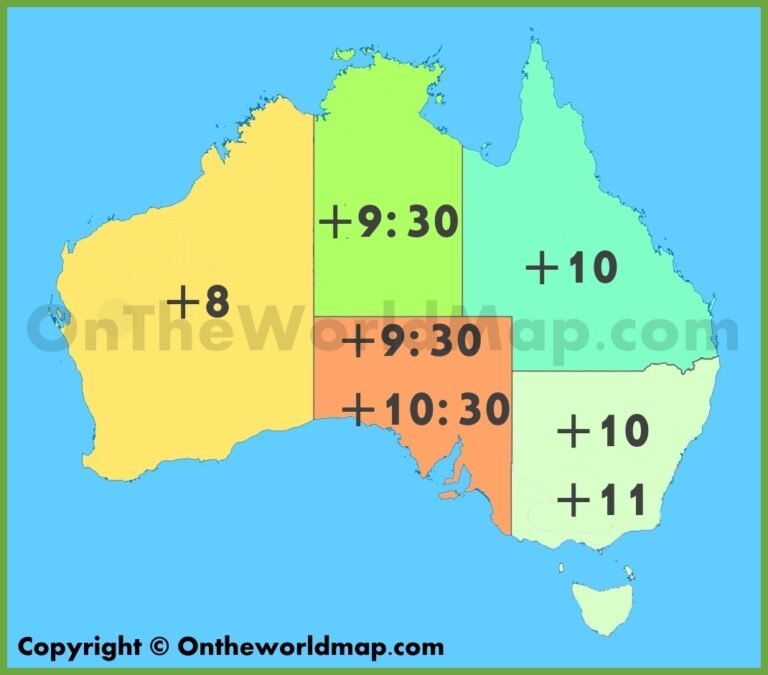Australia Time: Australia, an endless continent spanning across a few scopes, is home to a complex organisation of time zones. Due to its geological area, Australia encounters a wide extent of daylight hours throughout the year, requiring numerous time zones to ensure precise and steady timekeeping.
The Australian Eastern Standard Time (AEST) Zone
The most populous time zone in Australia is the Australian Eastern Standard Time (AEST) zone. It covers the eastern coast of the landmass, counting major cities like Sydney, Melbourne, Brisbane, and Canberra. AEST is 10 hours ahead of Coordinated Universal Time (UTC). Amid daylight sparing time (DST), the zone shifts to Australian Eastern Daylight Time (AEDT), which is 11 hours ahead of UTC.
The Australian Central Standard Time (ACST) Zone
The Australian Central Standard Time (ACST) zone, which is 9.5 hours ahead of UTC, ranges the central parts of Australia, counting Adelaide and Darwin. This zone moreover watches DST, moving to Australian Central Daylight Time (ACDT) amid the summer months.
The Australian Western Standard Time (AWST) Zone
The westernmost time zone in Australia is the Australian Western Standard Time (AWST) zone. It covers the western portion of the landmass, counting Perth. AWST is 8 hours ahead of UTC and does not watch DST.
The Northern Territory Time Zone
The Northern Territory of Australia works on an interesting time zone known as the Northern Region Time Zone (NT). It is 9.5 hours ahead of UTC and does not watch DST. This zone is utilized to adjust with the time zone of Papua New Guinea, which offers an arrival border with the Northern Territory.
The Lord Howe Island Time Zone
The little island of Master Howe Island, found in the Tasman Ocean, works on its claimed time zone, which is 10.5 hours ahead of UTC. This interesting time zone is utilized to maintain a half-hour contrast between Lord Howe Island and the Australian territory, permitting for helpful travel and communication between the two locations.
The Part of Daylight Saving Time (DST)
Many Australian states and domains watch Daylight Saving Time (DST), which includes moving clocks forward by one hour amid the summer months. The reason for DST is to maximize daylight hours and minimize the utilisation of counterfeit lighting, driving to vitality savings. Whereas most states and territories participate in DST, the Northern Domain and Western Australia do not.
Challenges and Adaptations
The presence of numerous time zones in Australia can display challenges for people and businesses. For occurrence, planning gatherings and arrangements over distinctive time zones can be complex. Also, travelers may encounter jet lag due to the noteworthy time contrasts between regions.
To relieve these challenges, Australians have created procedures and adjusted their lifestyles to oblige the time zone system. For example, businesses regularly utilize time zone converters and planning devices to arrange exercises over different regions. People may moreover alter their rest plans continuously to minimize the impacts of fly lag.
Conclusion
Australia’s time zone system is an imperative component of the country’s foundation, guaranteeing exact timekeeping and proficient utilisation of sunshine hours. Whereas the presence of different time zones can show challenges, Australians have adjusted to these complexities to maintain a functional and agreeable society.
FAQs
Does Australia watch Daylight Saving Time (DST)?
Most Australian states and regions watch DST, but for the Northern
What is the contrast in time between the eastern and western coasts of Australia?
There is a two-hour distinction between the eastern and western coasts of Australia.
When does Daylight Saving Time begin and end in Australia?
The correct dates for DST shift marginally between states and regions, but generally, it begins in the spring and closes in the autumn.
How does DST influence timekeeping in Australia?
When DST is in impact, clocks are set forward by one hour, resulting in longer daylight hours and shorter evenings.
Are there any apps or instruments to help me oversee time zones whilst traveling to Australia?
Yes, there are numerous time zone converter apps and instruments available online to help you oversee time contrasts whereas traveling.
Should I be mindful of any time zone-related traditions or behavior when visiting Australia?
It’s generally considered neighborly to be careful of time contrasts and to avoid planning meetings or arrangements at badly arranged times for your Australian hosts.
What is the time contrast between Australia and the United States?
The time distinction between Australia and the United States shifts depending on the particular time zones in each nation. For example, the time contrast between Sydney, Australia, and New York City, USA, is 15 hours.
What is the time distinction between Australia and India?
The time contrast between Australia and India changes depending on the particular time zones in each nation. For illustration, the time contrast between Sydney, Australia, and Kolkata, India, is 4.5 hours.
How can I effectively convert time between distinctive time zones in Australia?
There are numerous online time zone converter tools available that can help you rapidly convert time between diverse Australian time zones.
Are there any portable apps for time zone conversion?
Yes, there are a few versatile apps available that can help you change over time between diverse time zones, counting Australian time zones.
How can I avoid planning clashes when planning meetings or arrangements with individuals in distinctive Australian time zones?
Use a time zone converter to decide the fitting time for meetings or arrangements based on the participants’ locations.
Are there any tips for remaining organized and overseeing time successfully in Australia?
Consider utilizing a calendar or planning app that can help you oversee your time and appointments across distinctive time zones.
How can I avoid jet lag when traveling to or from Australia?
Gradually alter your rest schedule before your trip, and attempt to remain wakeful or dynamic amid the day to adjust your body’s inside clock with the nearby time.
To read more, click here
